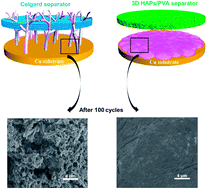A 3D flexible and robust HAPs/PVA separator prepared by a freezing-drying method for safe lithium metal batteries†
Abstract
Lithium (Li) metal batteries have shown great promise for next-generation electrical energy storage due to the unique features of lithium metal like light weight, high specific capacity, and the lowest anode potential. Nevertheless, the uncontrollable growth of dendritic and mossy Li, resulting in a low coulombic efficiency and serious safety concerns, has hindered the practical application of rechargeable Li-metal batteries. Here we report an environmentally friendly nanocomposite separator, comprising polyvinyl alcohol and hydroxyapatite, which exhibits an outstanding Young's modulus and high mechanical flexibility. We show that this separator can efficiently suppress the growth of dendritic Li and enable a homogeneous stable solid electrolyte interphase. Compared to lithium metal batteries using a commercial polyolefin-based separator, cells using the reported nanocomposite separator demonstrate a superior electrochemical performance with a much higher coulombic efficiency during the charge/discharge cycling at a practical current density of 2 mA cm−2. This work indicates that nanocomposite engineering could be a promising strategy to develop stable, safe and sustainable Li-metal batteries.



 Please wait while we load your content...
Please wait while we load your content...